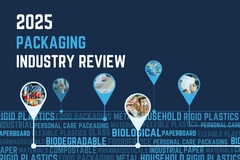AI in packaging: Leveraging new tech for recycling and real-time machine decision-making

AI continues to transform the packaging industry landscape. While much of the focus had originally been on its use in automation and machine learning, nearly all packaging sectors have integrated some form of AI.
Tracking industry adoption of AI can be challenging as it is continuously developing. Conversations are often rooted in popular narratives that hail the contribution of AI efficiency alongside the fear of job cuts.
Packaging Insights examines two aspects of AI utilized in the packaging industry to gain an in-depth understanding of its applications.
We speak to Miles Gander, chief technical officer at Birch Biosciences, about how the US-based company uses AI to design enzymes that depolymerize plastics.
We also speak to Marco Wittenzellner, professional lead for data science at T.Con, a Germany-based software company, who highlights how companies can implement AI to improve supply chain operations.
Wittenzellner says: “The packaging industry is facing the urgent challenge of reacting agilely to new market requirements. Digitalization plays a vital role in this endeavor, and AI is paving new paths toward increasing process efficiency and product quality.”
Gaining a competitive advantage
 Birch Biosciences uses AI to enhance the performance of its enzymatic plastic recycling technology (Image credit: Birch Biosciences)Wittenzellner identifies a key trend in packaging: the growing use of AI tools that analyze data and make real-time decisions on machines.
Birch Biosciences uses AI to enhance the performance of its enzymatic plastic recycling technology (Image credit: Birch Biosciences)Wittenzellner identifies a key trend in packaging: the growing use of AI tools that analyze data and make real-time decisions on machines.
“Predictive quality and closed-loop automation are also on the rise.”
Moreover, he highlights the increasing importance of multimodal models that combine image and sensor data, and “explainable AI” that offers manufacturers transparency.
“Whether packaging is made of fiber, glass, rigid plastics, or flexibles, AI can give manufacturers a competitive advantage by enabling them to respond more quickly to market and production changes.”
Recycling reinvented
Another way AI can be implemented in packaging is through enzymatic recycling processes.
Gander says: “At Birch, we are using AI to enhance the performance of our enzymatic plastic recycling technology. This is accomplished through AI-guided design of enzymes that efficiently depolymerize PET plastics to their chemical building blocks, which can then be repolymerized into virgin-quality 100% recycled resin.”
Birch works with a class of AI models branded Foundation Models, which are trained using multiple data types, such as enzyme sequence, structure, activity, and chemical reaction information.
“To feed our models, Birch has developed a proprietary enzyme engineering platform that includes a novel microfluidics technique that can measure the activity of millions of enzyme variants in a single experiment,” explains Gander.
The platform also features analytical and process development options for testing enzyme variants in industrially relevant conditions for commercial recycling processes.
Making big data manageable
For T.con, one advantage of AI stands out:“T.Con is dedicated to AI-supported machine data orchestration, which reveals practical benefits of a digitized shop floor,” explains Wittenzellner.
Wittenzellner says there is distrust around AI but communication and security can help companies implement it properly.The software company’s Smart IoT solution can determine management decisions and machine performance based on real-time data from IT and OT sources.
Wittenzellner discloses that when talking to customers, it is apparent that data quality is crucial for AI in automation. “Making big data manageable is the core idea of Smart IoT.”
The software can be integrated across all shop floor processes. It can be used in packaging automation and is easy to understand, according to Wittenzellner. Ultimately, he highlights that “AI can boost potential as a packaging manufacturer, as it can increase process efficiency and product quality.”
Tackling AI skepticism
Wittenzellner notes that using AI is not without its challenges. There is general distrust of the system, as consumers and industry players often believe it will replace existing jobs.
He argues: “Common misconceptions include that AI is a ‘black box’ and too difficult to understand or control. My advice is: Get your entire team on board. Using AI requires good communication to prevent fear and rumors.”
AI skepticism also arises from data quality and the effort required for successful implementation.
“Some believe that AI projects need to be massive, and they only make sense for large corporations with huge amounts of data. This may cause uncertainty and hesitation. However, it has never been expedient to wait and see in such a competitive industry like packaging.”
Birch uses AI to develop its recycling operations. According to Gander, enzymatic recycling without AI is inefficient, slow, and non-targeted.
“Traditional enzyme design methods heavily rely on non-targeted, randomized search for improved enzymatic performance, and are much less efficient in identifying enzyme mutations that improve performance. Non-AI guided, legacy optimization of industrial enzymes can take years.”
Moreover, using AI helps Birch make changes to the most effective enzymes. This enables its recycling technology to tolerate higher feedstock impurity levels than mechanical and chemical recycling while also reducing the energy required for plastic recycling.
AI and the environment
At Birch, using AI to help create enzymes impacts the sustainability of its recycling processes. According to the recycling company, it has improved the performance of its leading PET enzyme by over 450-fold in 18 months.
The PET enzyme can generate greater than 95% yield from post-consumer PET packaging and helps manufacture fully recycled PET (rPET) resin at the same price point as virgin material.
Gander explains: “Because of the low-energy inputs required for the efficient operation of our end-to-end enzymatic recycling process, the rPET produced from Birch’s recycling process generates 70% less GHG emissions than virgin PET production.”
Birch plans to scale its PET enzymatic recycling process to a one metric ton per day pilot facility. Gander says that material produced at this facility will be used for customer test manufacturing to secure off-take agreements, “ultimately enabling the construction and operation of our first commercial-scale plant.”
Becoming the norm
 Birch’s AI platform is “plastic agnostic,” meaning it has potential to create enzymes that break down all plastics (Image credit: Birch Biosciences).Birch’s AI platform is “plastic agnostic”, says Gander, meaning that it can be applied to plastic types beyond PET. “The multi-polymer nature of our data imbues our foundation models with capabilities for rapid, high-performance enzyme design to address other plastics.”
Birch’s AI platform is “plastic agnostic,” meaning it has potential to create enzymes that break down all plastics (Image credit: Birch Biosciences).Birch’s AI platform is “plastic agnostic”, says Gander, meaning that it can be applied to plastic types beyond PET. “The multi-polymer nature of our data imbues our foundation models with capabilities for rapid, high-performance enzyme design to address other plastics.”
Birch aims to use its AI platform to achieve enzymatic recycling of more types of plastic.
“A ‘cocktail’ of high-performance enzymes could be used to break down multi-polymeric materials like polyurethanes, nylon, and others commonly found in textiles and durable goods such as furniture and automobiles,” explains Gander.
Meanwhile, Wittenzellner says for T.Con, “it is crucial to get involved and become part of the AI applicants.”
“Self-learning models will become more robust and adaptable through continuous feedback. Integration with sustainability tools (like for real-time CO2 footprint calculation) is becoming the norm.”
AI will also become more accessible to non-data scientists as it combines with low-code and no-code interfaces.
While advocating for its integration into packaging systems, Wittenzellner also notes that imagining future AI systems has limits.
“Making predictions regarding the future of AI is tricky, as it evolves utterly fast. It is important to break down major trends into hands-on solutions. An off-the-shelf solution is not advisable to become a trendsetter or be ahead of competitors.”











